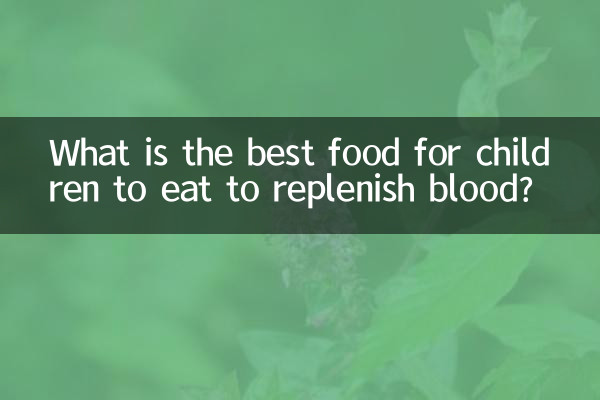What is the best food for children to eat to replenish blood?
In recent years, the problem of anemia in children has attracted much attention from parents. Anemia not only affects the growth and development of children, but may also lead to problems such as reduced immunity and inability to concentrate. So, what kind of food is best for children to replenish blood? This article will combine the hot topics and hot content on the Internet in the past 10 days to provide you with a scientific and practical guide to blood-enriching diet.
1. Main causes of anemia in children

The main causes of anemia in children include insufficient iron intake, malabsorption, and chronic blood loss. Among them, iron deficiency anemia is the most common type. Therefore, the key to replenishing blood is to supplement iron and combine it with nutrients that promote iron absorption.
| anemia type | main reason | High-risk groups |
|---|---|---|
| iron deficiency anemia | Insufficient iron intake or malabsorption | Infants and adolescent children 6 months to 2 years old |
| megaloblastic anemia | Folic acid or vitamin B12 deficiency | Picky eaters, children from vegan families |
| hemolytic anemia | Too much red blood cell destruction | Children with a family history of genetic disease |
2. Foods with the best blood-enriching effect
According to nutritional research and clinical practice, the following foods have a significant effect on replenishing blood in children:
| food category | represents food | Iron content (mg/100g) | Absorption characteristics |
|---|---|---|---|
| animal liver | Pork liver, chicken liver | 22.6 | Heme iron, high absorption rate (20-30%) |
| red meat | Beef, mutton | 3.2-3.7 | Heme iron, moderate absorption (15-20%) |
| animal blood | duck blood, pig blood | 8.7-30.5 | Heme iron, high absorption rate |
| Seafood | oysters, clams | 5.0-7.1 | Heme iron, high absorption rate |
| plant food | Black fungus, spinach | 2.6-8.6 | Non-heme iron, low absorption (2-5%) |
3. Scientific combination of blood-enhancing foods
Simply supplementing iron is not enough. You also need to pay attention to the following matching principles:
1.Vitamin C promotes iron absorption: When consuming iron-containing foods, paired with fruits and vegetables rich in vitamin C, such as oranges, kiwis, green peppers, etc., the iron absorption rate can be increased by 3-6 times.
2.Avoid foods that inhibit iron absorption: Phytic acid in tea, coffee, whole grains, and calcium in milk will inhibit iron absorption and should be avoided with iron-supplementing foods.
3.Protein assists hematopoiesis: High-quality protein is an important raw material for synthesizing hemoglobin. It is recommended to ensure an appropriate amount of meat, eggs, and milk intake every day.
4. Recommended blood-enriching recipes for children of all ages
| age group | Recommended recipes | Frequency of consumption |
|---|---|---|
| 6-12 months | Liver porridge (pork liver 10g + rice 30g + carrot 20g) | 2-3 times a week |
| 1-3 years old | Beef and spinach cake (50g beef + 30g spinach + 1 egg) | 3-4 times a week |
| 3-6 years old | Duck blood and tofu soup (50g duck blood + 50g tofu + 1 tomato) | 2-3 times a week |
| school-age children | Oyster scrambled eggs (100g oysters + 2 eggs + 1 green pepper) | 1-2 times a week |
5. Common misunderstandings about blood supplementation
1.Red date brown sugar has limited blood-enhancing effect: Although red dates and brown sugar contain a certain amount of iron, they are non-heme iron and have low absorption rates, so they are not suitable as the main blood-enriching food.
2.Replenishing blood cannot only rely on food supplements: Children with moderate to severe anemia should be treated with iron supplements under the guidance of a doctor. The effect of dietary supplements alone is limited.
3.Risks of taking too much iron: Excessive iron supplementation may lead to iron poisoning and symptoms such as nausea and vomiting. It is recommended to have regular blood tests.
6. Daily life suggestions to prevent anemia
1. Regular physical examination: It is recommended that children over 6 months old have their hemoglobin tested every 3-6 months.
2. Scientific feeding: Breastfed babies should pay attention to iron supplementation after 4 months, and formula-fed babies should choose iron-fortified formulas.
3. Develop good eating habits: avoid picky eaters and ensure a diverse diet.
4. Appropriate exercise: Moderate aerobic exercise can promote blood circulation and improve hematopoietic function.
Conclusion: Children’s blood replenishment is a systematic project, which requires scientific selection of food, reasonable combination of nutrients, and regular monitoring of effects. We hope that the introduction in this article can help parents develop more scientific and effective blood replenishment plans for their children, so that their children can stay away from anemia and grow up healthily.

check the details

check the details